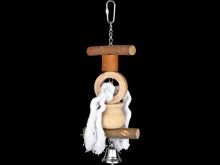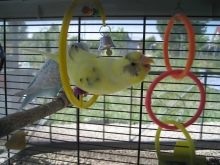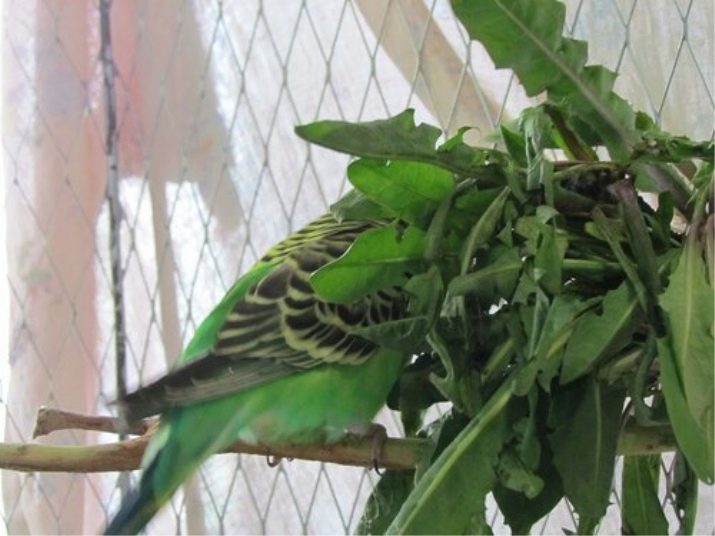DIY parrot toys

Parrots are perhaps one of the smartest birds, and therefore constantly need some interesting and exciting activity. We cannot spend all our time with them, so toys serve a valuable function in keeping birds in captivity happy and less prone to developing unwanted behaviors such as pinching, screaming, or repetitive movements.
Unfortunately, for most parrots, the usual way of playing is to chew on any object they love, and if you buy the toys they need, the cost is global. With a little ingenuity and lots of fun, you can create toys from household items, natural materials, and scrap materials without spending any money.
Interesting ideas for making toys with your own hands
Climbing wire hanger
Your pet will like this toy the most. Most of the cages are not large enough, and such a toy, without taking up much space, will increase the territory for a parrot to climb.
- Hang a hook from the ceiling of the cage.
- Next, three loops are made, which cling to each other.
- You can attach some treats for your pet along the entire length of such a vine. And you can focus only on the bottom of such a hanger and tie the treat only at the bottom.

Ropes in the house, aviary and poultry house
In a room where birds can move outside the cage, handrails should be installed on hooks attached to the wall. Ropes are attached on both sides. Thus, the cable installed in a suspended state can be removed when your bird has enough play and is back in the cage.
Domestic budgies will be happy to play on the ropes for hours, swinging cheerfully. Once they stop climbing the rope back and forth and swinging, it's time to give them some rest. Parrots can be closed in a cage and ropes removed before the next bird walk. The same, but smaller, ropes can be hung in the aviary.
Before choosing a rope for a swing for parrots, you should carefully examine the rope for abrasions, because the bird can catch on its leg and injure its neck.



Homemade toys for walking
Wrap a treat or toy in woven fabric and hang in the cage. You can use harmless plant leaves or pine cones, small boxes used to store pills, and other similar household items instead of wicker material.
Parrots will be happy to play with a treat wrapped in a wicker rug and suspended from the ceiling of the cage, like little ones with Christmas gifts.
Parrots often prefer packaging to toys or treats inside.
Balsam wood toys are sold and expensive, but parrots are very fond of walnut, they also really like the soft type of wood. By the way, you can buy balsa wood at a store that sells materials for artisans.



Willow wreath
- Make a circle with stiff wire and make sure the ends are tied securely. You can also use a hoop if there is enough room in the cage to hang it. You will need 20 to 50 willow twigs to form a soft and beautiful 30 cm to 2 m wreath.
- You can remove the willow leaves from the twigs, or you can leave them. The willow branches should be wrapped around a wire circle or hoop. This is an easy activity that will take about 40 minutes of your time. The ends of the twigs can be tied with a thin wire. The next day, the wires can be unscrewed, the willow branches will retain their shape.
- On such a ready-made wreath made of natural materials, you can hang treats, flowers or small toys. If you hang roses, your parrots will be happy to pick and eat flower petals.
The willow wreath itself will last longer than three months if weaved a lot of threads into it. Smaller wreaths can be made for cells.


Home swing
Any tube with a hole through which you can pass a wire or rope is suitable for making a swing, where your parrots will happily swing or just sit. For hanging, you can use a rope, chain, or plastic chain, which can always be purchased at the hardware store. Birds love to swing. Wild birds swing in trees, and this behavior is considered natural for domestic parrots.



Flowers
Birds love to chew flowers. Many wild birds have only flowers in their diet. If you are using purchased plants not from your garden, then it is advisable to thoroughly rinse them to wash off the existing preservative or insecticide.
Some flowers are poisonous, such as datura, laburnum, and foxglove.
Holly and poinsettia are also not recommended for parrots. In fact, treating your pet with flowers, you will soon understand which of the flowers is his favorite.

Foliage
If your house is located outside the city and surrounded by its own garden, your parrot is very lucky, because it will not be difficult for you to collect dandelions, cut off young willow twigs or collect fresh acorns for birds. Compared to urban greenery, foliage outside the city does not contain dangerous insecticides and is not saturated with exhaust fumes.
In aviaries, shy birds are clearly happier when they have the opportunity to hide in green foliage. For city dwellers, there is such great advice as growing your parrot's favorite greens at home on the balcony, in clay pots. If you don't know where the foliage that you are going to add to the parrot's cage is from, then it is best to rinse it first.

Never use chemicals, household cleaners, or bleach to disinfect bird toys.
Birds love branches. Disinfect the twigs if they have any insects or herbicides on them... By the way, driftwood, once brought to the house from the beach, for example, will become not only an excellent decoration element for an open-air cage or large cage - birds will gladly climb them.


Carton boxes
Small cardboard boxes make a great toy for your parrot. Birds love to play with them. You can make a small birdhouse out of a cardboard box, and you will see with what pleasure your parrot will climb on it and stay there during the day. The birds will not only hide in such a cardboard box, but also chew and tear paper with pleasure.

Recommendations
Toys with tiny details should be avoided unless they are made of wood. Some parrot owners, considering the stuffing of soft toys dangerous, do not give them to their winged pets. In fact, even soft toys can be given to parrots to play, but you just need to be careful: when the toy is torn and the inner filler comes out, the toy will need to be removed from the cage.
Young parrots really like to cuddle up to a soft toy, maybe because it reminds them of a brother or sister with whom they grew up in the nest.
If you want to keep your birds safe, do not buy items that do not have a “Safe” label or logo.

Shy birds
Some poultry that are not familiar with toys, since they are still very young, will be afraid of everything new and strange.
Older individuals already have experience and therefore can teach younger ones how to play with toys easily and with pleasure.
Fear of toys is overcome with patience. Place the toy in the cage for your bird to see. At the same time, you need to observe the behavior of the parrot, which will tell you with body language that you put the toy too close, and because of this, he is not very comfortable.

The toy can be moved closer and closer every day. Eventually, most birds will accept the strange object. Just don't rush.
You can also play with your new toy in front of your parrot. It may take a few days before your bird starts playing with the toy.
Finally, know that your bird's favorite toy is yourself. Therefore, communicate with your feathered friend more often and give him more of your attention and time.
How to make toys for a parrot with your own hands, see below.









Cool! Thanks to the author for the great ideas!
My wavy lines are not tame and do not like me. When I hang them beads, they play with them all day. They enter the box by force, but they can sit there for a long time.